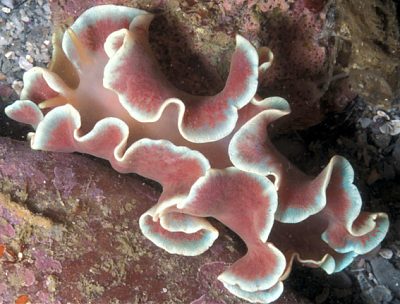

Leminda millecra
Griffiths, 1985
Order: NUDIBRANCHIA
Suborder: ARMININA
Family: Charcotiidae
DISTRIBUTION
It is known only from South Africa
PHOTO
Port Elizabeth, Eastern Cape, South Africa. Size range 40-80mm. Upper: depth of 13m, 23 February 2002, L: 40 mm. Lower: depth of 10m, 24 February 2002, L: 60mm. Photos: Lindsay Warren.
The mantle is relatively thin and thrown into large sinuous folds. There is a break in the mantle edge anteriorly between the rhinophores, and a large oral veil. The rhinophores are smooth and tapering, and do not retract into a pocket. The digestive gland is divided into relatively fine ramifying ducts which can be seen through the translucent body wall. The colour of the animal is largely dependent on the colour of the food in the digestive gland ducts.
This unusual animal was placed in a separate Family, Lemindidae, by Griffiths, but is at present considered to be related to Charcotia, a monotypic genus, and Pseudotritionia, a genus with two known species. They all have arminiform bodies, simple rhinophores and branching digestive gland ducts. Gosliner (1985) reports this species from 10m to at least 40m. See message suggesting it eats a soft coral Alcyonium fauri and a gorgonian Leptogorgia palma. It is known only from South Africa.
References:
• Gosliner, T.M. (1987) Nudibranchs of Southern Africa, a guide to the Opisthobranchs of southern Africa. Sea Challengers, Monterey. 136pp.
• Griffiths, R. (1985) Description of a new South African arminacean and the proposed re-instatement of the genus Atthila Bergh (Mollusca: Opisthobranchia). Annals of the South African Museum, 95: 269-280.
Rudman, W.B., 2002 (September 29) Leminda millecra Griffiths, 1985. [In] Sea Slug Forum. Australian Museum, Sydney. Available from http://www.seaslugforum.net/find/lemimill
Related messages
Leminda millecra showing its all!
February 6, 2007
From: Charles Rowe
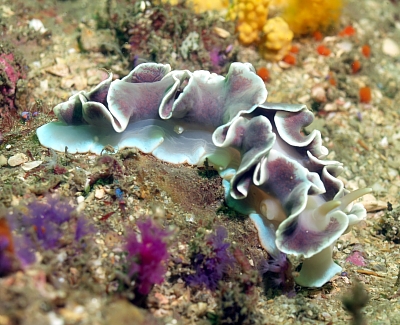
Hi Bill,
I just thought I might send this photo as it shows everything in one shot. Rhinophores, mouth piece and reproductive organ are all easily visible.
Locality: Shyshark Reef, Port Elizabeth, 14 matres, South Africa, Indian ocean, 23 December 2006, On a sandy patch just off the reef.. Photographer: Charles Rowe.
Charles Rowe
bumff@mweb.co.za


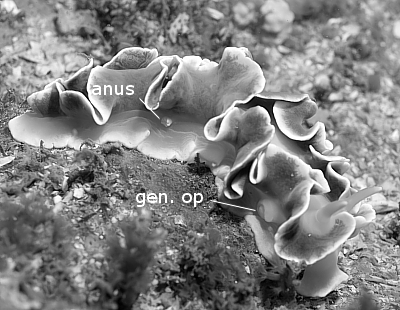
Dear Charles,
Thanks for this great photo. It s certainly interesting how the head / oral tube extends out so far. Apart from the structures you mentioned your photo also shows the anus opening on the right side towards the back of the body. The purplish branching material we can see through the skin, is the branching digestive gland, which in molluscs, functions not only as the liver - as it is often mistakenly called - but as a place where digestive enzymes are produced and food particles are absorbed and broken down. It is a multifunctional organ. In an earlier message [#11245] I suggested that the purple clumps of contracted soft coral in your photos were the food of Leminda. In this photo, what I assune are the same soft corals are fully extended, and certainly their colour matches the colour of the slug's digestive gland. This species is reported to eat the soft coral Alcyonium fauri [message #8164]. I wouldn't mind betting that the soft coral in your photos is a purple form of that species.
Best wishes,
Bill Rudman
Re: Leminda millecra from South Africa
November 15, 2006
From: Wilhelm van Zyl

Concerning message #18203:
Hi Bill,
When I saw these pictures I remembered some pictures I took some time ago. This was on a dive on a pinnacle almost in the middle of False Bay called Whittle rock.
Locality: False Bay, Whittle Rock, 20m, South Africa, Indian Ocean, 7 May 2005, Reef. Length: 5cm. Photographer: Wilhelm van Zyl.
Wilhelm van Zyl
diving@cyberdale.co.za
Van Zyl, F.W, 2006 (Nov 15) Re: Leminda millecra from South Africa. [Message in] Sea Slug Forum. Australian Museum, Sydney. Available from http://www.seaslugforum.net/find/18289
Dear Wilhelm,
Thanks for the photo. It's a bit hard to untangle the animals but I assume there are two in your photo? I guess the small egg mass on the left of the photo belongs to them.
Best wishes,
Bill Rudman
Leminda millecra from South Africa
November 6, 2006
From: Georgina Jones
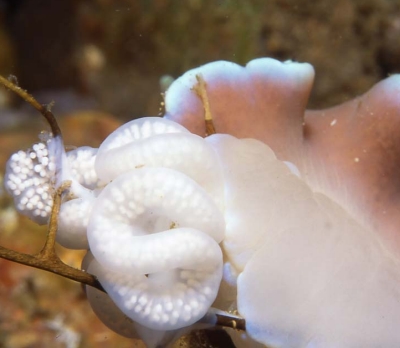

Concerning message #18195:
Dear Bill,
Here are photos of Leminda millecra laying eggs and of its egg ribbon -- as you can see, the eggs are pretty chunky. I was so pleased when we got these pictures, because, of course, unless one catches them in the act of laying, the identification of the egg ribbon remains uncertain.
Locality: False Bay, Smitswinkel wrecks, 28m, South Africa, False Bay, june 2005, horizontal surface of wreck. Length: 70mm. Photographer: Sharon Albert
Best wishes
Georgina
.
gjones@icon.co.za
Jones, G.J., 2006 (Nov 6) Leminda millecra from South Africa. [Message in] Sea Slug Forum. Australian Museum, Sydney. Available from http://www.seaslugforum.net/find/18203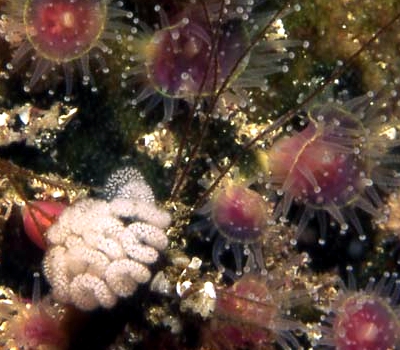
Dear Georgina,
Thanks for this valuable piece of information. I am pretty sure photos of this species' egg mass have not been published before
Best wishes,
Bill Rudman
Leminda millecra - feeding record
October 16, 2003
From: Charles Rowe

Hi Bill,
We managed to get a dive in on Saturday but the vis was miserable only 2-3 metres so my nose was stuck to the reef. Fortunately I managed to get some really good photos including the ones below. All were taken on
11 October 2003 at Whitesands, Port Elizabeth [South Africa] at 14 metres.
This one is of a nudi I don't think I have sent to you before. This one was quite large maybe 500 - 600mm in length.
By the way I use an Olympus C4000z in an Olympus housing with Ikelite DS 50 and TTL sensor. We missed out on another dive on Sunday which had 10 to 15 metres
vis which is exceptional for Port Elizabeth but never mind we will be doing the same spot Gasmic this weekend with a bit of luck. Lots of nudis there as well so
expect more photos:-)
See ya.
Charles...
bumff@mweb.co.za
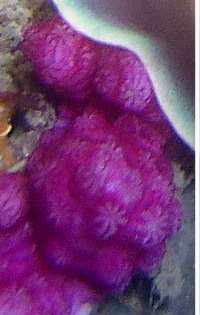
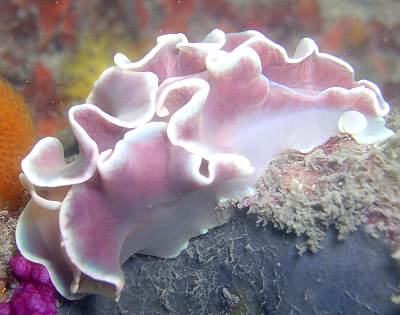
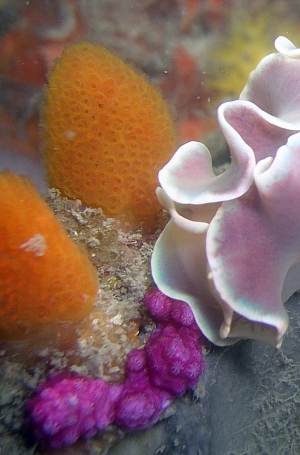
Thanks Charles,
This is Leminda millecra which is only known from temperate South Africa. If you look at my earlier message we still are not sure what this species feeds on - though at 60cm it is clearly eating something quite obvious. The circumstantial evidence is that it could be feeding on both a soft coral Alcyonium fauri and a gorgonian Leptogorgia palma.
I am pretty sure from your photo that this animal is feeding on the purple soft coral colony in your photo. If you look at the photo on the Fact Sheet you will see that the flap of tissue over the soft coral is not the foot but the oral veil. Also you will see a faint purplish-pink shadow in the nudibranch. This is the branching digestive gland and its colour matches the colour of the soft coral colony quite well. All in all I think you have discovered the food of this species. It would be nice to get this positively identified. It would also be nice to get some further records of it feeding to confirm the information, and also to check whether you ever find it on a gorgonian, which is its other possble food.
Best wishes
Bill Rudman
Leminda millecra from South Africa
February 5, 2003
From: Valda Fraser

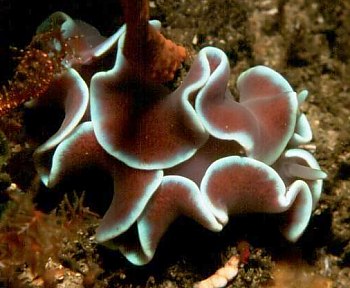
Dear Bill,
Delighted that these beautiful nudibranchs, Leminda millecra are quite plentiful in the Eastern Cape. Trouble is they seldom strike the "right" pose!
Locality: Jeffrey's Bay, Eastern Cape, South Africa, Depth: 20m. Size: 60mm. Jan 2003
Regards,
Valda Fraser
valdafraser@mweb.co.za
Fraser, V., 2003 (Feb 5) Leminda millecra from South Africa. [Message in] Sea Slug Forum. Australian Museum, Sydney. Available from http://www.seaslugforum.net/find/9086Thanks Valda,
Bill Rudman
Food of Leminda millecra
October 14, 2002
From: Bill Rudman
In my recent comments about Leminda millecra I mentioned that we did not know what it fed on. I have recently come across a recent paper which suggests that it eats a soft coral Alcyonium fauri and a gorgonian Leptogorgia palma
• McPhail, KL; Davies-Coleman, MT; Starmer, J. 2001. Sequestered chemistry of the arminacean nudibranch Leminda millecra in Algoa Bay, South Africa. Journal of Natural Products, 64 (9): 1183-1190.
In the paper they describe how extracts of Leminda millecra collected in Algoa Bay, South Africa, yielded four known metabolites, millecrones A (1) and B (2), isofuranodiene (5), and (+)-8-hydroxycalamenene (9), and nine new compounds, algoafuran (7), cubebenone (8), and a series of seven triprenylquinones and hydroquinones (21-27). A subsequent survey of possible octocoral prey species in Algoa Bay identified the soft coral Alcyonium fauri as the source of 1 and the gorgonian Leptogorgia palma as the species producing 2 and 8.
Cheers,
Bill Rudman
Leminda millecra from South Africa (1)
October 1, 2002
From: Lindsay Warren


Dear Bill
As requested, please find attached some shots of two specimens of Leminda millecra Griffiths, 1985. The photos of the other animal are in a separate message. Both were found while diving off Port Elizabeth in the Eastern Cape, South Africa along with many others which varied in size from 40-80mm. They are quite stunning animals. The overall topography of the area is of large boulders with gulleys in between. The boulders are bristling with sponges, bryozoans, algae, gorgonians and small hydroids.
Water temp: a very chilly 15-16C.
I found LCRW0003(this message) at a depth of 13m on 23 February 2002, L: 40 mm.
All the best
Lindsay
alldcl@compuserve.com
Warren, L., 2002 (Oct 1) Leminda millecra from South Africa (1). [Message in] Sea Slug Forum. Australian Museum, Sydney. Available from http://www.seaslugforum.net/find/7925Dear Lindsay,
When you mentioned in an earlier message you had seen Leminda, I just had to ask if you had any photos of this strange animal. It would be very interesting to know what this animal ate. We know nothing of its diet, or that of the related Charcotia and Pseudotritionia. I have included some close-ups to show the distinctive branches of the digestive gland.
Best wishes,
Bill Rudman
Leminda millecra from South Africa (2)
October 1, 2002
From: Lindsay Warren

Dear Bill
Here are photos of a second animal of Leminda millecra to accompany those in my earlier message. As before, it was found while diving off Port Elizabeth in the Eastern Cape, South Africa along with many others which varied in size from 40-80mm. Water temp: a very chilly 15-16C. This animal was found at a depth of 10m on 24 February 2002, L: 60mm.
All the best
Lindsay
alldcl@compuserve.com


Thanks Lindsay,
Bill Rudman
